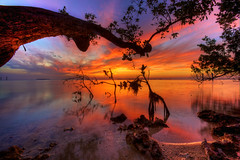Mangroves, salt marshes and sea grasses soak up to five times more carbon than tropical forests, making their conservation critical
Mangroves are tangled orchards of spindly shrubs that thrive in the interface between land and sea. They bloom in muddy soil where the water is briny and shallow, and the air muggy. Salt marshes and sea grasses also flourish in these brackish hinterlands. Worldwide, these coastal habitats are recognized for their natural beauty and ability to filter pollution, house fish nurseries and buffer shorelines against storms.
Less known is their ability to sequester vast amounts of carbon—up to five times that stored in tropical forests. Dubbed “blue carbon” because of their littoral environment, these previously undervalued coastal carbon sinks are beginning to gain attention from the climate and conservation communities.
Because they hold so much carbon, destroying them can release substantial amounts of CO2. People around the world wreck coastal habitats through aquaculture, agriculture, timber extraction and real estate development. To date, human encroachment has destroyed more than 35 percent of mangroves, 30 percent of sea grass meadows and 20 percent of salt marshes.





